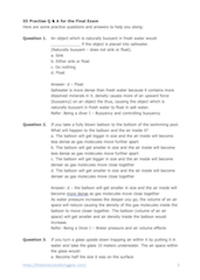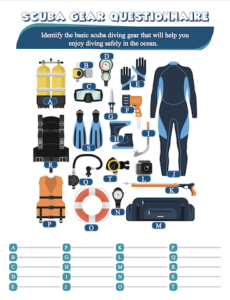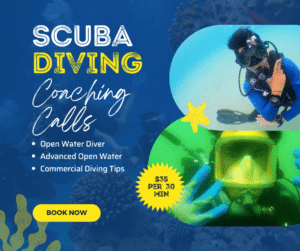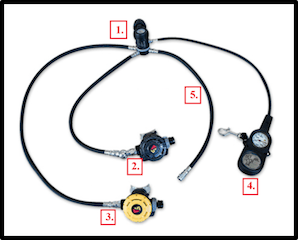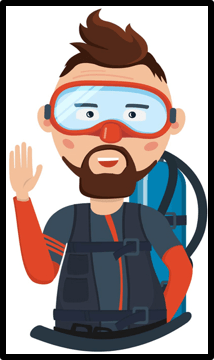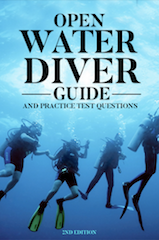PADI Open Water Diver
Заключительный экзамен.
Вариант А (Теория)
Предмет имеет нейтральную плавучесть (не тонет и не всплывает) в пресной воде. Если этот же предмет поместить в соленую воду, то он:
Либо утонет, либо будет удерживаться на плаву
С ним ничего не произойдет
Будет удерживаться на плаву
Представьте, что у вас в руках шарик, который вы надуваете, завязываете и опускаете на дно бассейна. Что произойдет с шариком и воздухом внутри него?
Шарик увеличится в размерах, а плотность воздуха внутри него уменьшится (расстояние между молекулами воздуха увеличится)
Шарик уменьшится в размерах, а плотность воздуха внутри него увеличится (расстояние между молекулами воздуха уменьшится)
Шарик увеличится в размерах, и плотность воздуха внутри него увеличится (расстояние между молекулами воздуха уменьшится)
Шарик уменьшится в размерах, и плотность воздуха внутри него уменьшится (расстояние между молекулами воздуха увеличится)
Представьте, что вы берете станкан с воздухом, переворачиваете его и помещаете в воду. Со стаканом в руках вы погружаетесь на глубину 10 метров. Что при этом произойдет с объемом воздуха в стакане?
Объем воздуха уменьшится вдвое по сравнению с объемом, который был на поверхности
Объем воздуха не претерпит никаких изменений
В стакане окажется треть того объема воздуха, который был на поверхности
В стакане окажется 2/3 того объема воздуха, который был на поверхности
Если у вас не получается продуться (выровнять давление в воздушных полостях тела), причиной тому может быть:
Сердечное заболевание и высокое артериальное давление
Простуда, аллергия и другие заболевания дыхвтельной системы
Если во время спуска у вас появляется боль в ушах или придаточных пазухах носа, это в боьшинстве случаев свидетельствует о том, что:
Вы выравняли давление в воздушных полостях (продулись)
Ремень вашей маски затянут слишком туго
Вы ощущаете сдавливание воздушной полости и вам необходимо продуться
Представьте, что вы находитесь на глубине 10 метров и держите в руках стакан, перевернутый вверх дном и заполненный воздухом из вашего баллона. Что произойдет с воздухом в стакане при подъеме (всплытии на поверхность)?
Расширяющийся воздух будет выходить из стакана снизу в виде пузырьков
Никаких изменений происходить не будет
Все вышеперечисленное не верно
Задержка дыхания во время погружения может привести к:
Проникновению воздушных пузырьков в кровеносное русла и в грудную клетку
Травмам, несущим угрозу для жизни
Если дайвер, находясь на поверхности и сохраняя нормальный ритм дыхания, расходует воздух из баллона за 60 минут, на сколько ему хватит этого воздуха на глубине 20 метров?
Как часто вы должны обращаться в дайв-центр для проведения визуального осмотра вашего баллона?
Через каждые шесть месяцев
Как отличить вентили с соединением типа YOKE от вентилей с соединением типа DIN
Вентили с соединением типа DIN сделаны из прочной пластмассы
Вентили с соединением типа DIN имеют пружинный запорный клапан удерживаемый в открытом состоянии давлением в баллоне
На вентипе с соединением типа DIN установлена О-кольцо (кольцевое уплотнение)
Вентили с соединением типа DIN имеют отверстие с резьбой, куда вкручивается регулятор
Какие действия предполагает правильный уход за баллоном?
Подвергать пескоструйной обработке и перекрашивать раз в год
Не опустошать баллон полностью
Проводить проверку давления в баллоне раз в месяц
Взгляните на фотографию регулятора. Отдельные элементы пронумерованы. Выберите правильные наименования
1 — шланг инфлятора низкого давления к компенсатору плавучести, 2 — вторая ступень регулятора, 3 — первая ступень регулятора
2 — вторая ступень алтернативного источника воздуха, 3 — первая ступень регулятора, 6 — шланг альтернативного источника воздуха
3 — вторая ступень регулятора, 4 — первая ступень регулятора, 5 — консоль инструментов / приборы / компьютер
1 — шланг инфлятора низкого давления к компенсатору плавучести, 2 — вторая ступень регулятора, 6 — шланг источника воздуха
Под водой предметы кажутся ________, чем в действительности. Когда вы смотрите на предметы под водой, вам также кажется, что они находятся ________, чем на поверхности.
_______ распространяется в воде быстрее. Поэтому бывает сложно определить, откуда (он/оно) исходит.
Как следует двигаться в воде?
Медленно, придерживаясь вертикального профиля
Если под водой вы подвергаетесь большой нагрузке и ощущаете, что вам трудно дышать, вы должны:
Надуть компенсатор плавучести
Прекратить любую физическую активность, отдохнуть, ухватиться за что-либо, если существует такая возможность
Плыть к своему напарнику и жестом показать, что вам нужна помощь
Совершить контролируемое аварийное всплытие (CESA — осуществление всплытия на поверхность с произнесением звука «а-а-а-а»)
Что происходит с мокрым гидрокостюмом, когда вы погружаетесь на дно?
Он подвергается сжатию (становится тоньще) под действием давления, поэтому чем больше вы погружаетесь, тем меньше становится ваша плавучесть и тем больше тепла вы теряете
Он подвергается расширению (становится толще) под действием давления, поэтому с увеличением глубины ваша плавучесть увеличивается, сохраняется больше тепла
Под действием давления толщина костюма не изменяется, поэтому с увеличением глубины не изменяются теплозащитные свойства
Все вышеперечисленное неверно
Вы знаете, что правильно подобрали груз (определили его необходимое количество), если вы:
Заполнив наполовину компенсатор плавучести, сделав нормальный вдох и задержав дыхание, удерживаетесь на воде на уровне шеи
Удалив воздух из компенсатора плавучести, сделав нормальный вдох и задержав дыхание, медленно идете ко дну
Удалив воздух из компенсатора плавучести, сделав нормальный вдох и задержав дыхание, удерживаетесь на воде на уровне глаз
Частично надув компенсатор плавучести, тонете
Определите значение сигнала
Стоп, стойте, остановитесь
Определите значение сигнала
В какую сторону следует двигаться
Определите значение сигнала
Все в порядке? ОК, все в порядке
Держитесь ближе друг к другу
Определите значение сигнала
Приветствие друзьям на берегу
Мне нужен дополнительный груз
Терплю бедствие, помогите
Хочу, чтобы меня подобрало судно
Определите значение сигнала
Все в порядке? ОК, все в порядке (на поверхности)
У меня судорогой свело ногу
Хочу поплавать и понырять с трубкой
Готов подняться на борт судна
Определите значение сигнала
В какую сторону двигаться, чтобы попасть на судно
Вода доходит до такого-то уровня
Двигайтесь в этом направлении
Определите значение сигнала
Определите значение сигнала
Что необходимо делать, если под водой вы с напарником потеряли друг друга (разлучились)?
Подняться на поверхность, подождать там напарника в течение одной минуты и спуститься обратно
Искать напарника в течение одной минуты, после чего осуществить всплытие, чтобы встретиться с ним на поверхности
Сразу же совершить всплытие и выйти из воды
Постараться обнаружить позырьки воздуха напарника и по этим пузырькам найти напарника
Под водой существует вероятность того, что вы потеряете способность ориентироваться в пространстве (состояние, в котором сложно определить где верх, а где низ), находясь _______. Это может произойти из-за _________.
на дне; отсутствия визуального ориентира
в толще воды; увеличения давления
на дне; увеличения давления
в толще воды; отсутствия визуального ориентира
Представьте, что начало погружения проходит в условиях слабого течения. Как вам следует плыть?
Против течения (ему навстречу)
Структура дна может оказать существенное влияние на:
Видимость (то как далеко вы видете в горизонтальном направлении под водой)
Плавучесть (зависаете вы или тонете)
Причина большинства травм и повреждений, наносимых водными организмами, кроется в том, что:
Животное проявляет любопытство
Животное пытается защитить себя
Какие из перечисленных ниже действий и проявлений говорят о том, что дайвер, находящийся на поверхности испытывает проблемы?
Дайвер держит голову высоко над водой, его маска снята, а регулятор (трубка) не находится во рту
Движения дайвера не медленные и размерянные, а судорожные и быстрые
Дайвер не реагирует адекватно на указания
Все вышеперечисленное верно
У вас заканчивается воздух в тот момент, когда вы находитесь рядом с напарником. Какой выход в данной ситуации является предпочтительным?
Перейти на дыхание из альтернативного источника воздуха, представленного напарником
Совершите контролируемое аварийное всплытие (CESA — осуществление подъема с произнесением звука «а-а-а-а»)
Совершите аварийное всплытие с положительной плавучестью (сбросить грузы)
Все вышеперечисленное верно
Если ваш регулятор под водой начинает травить (работать в режиме свободного тока воздуха — free flow), вы должны:
Удерживать регулятор во рту, позволяя избыточному воздуху выходить из выпускного клапана
Не совершать каких либо специальных действий
Не сжимать загубник регулятора ртом слишком крепко, осторожно вдыхать необходимое количество воздуха и совершать при этом всплытие (подъем)
Совершите аварийное всплытие с положительной плавучестью (сбросить грузы)
Представьте, что постражавший дайвер находится на суше, он не слушает вас и не отвечает на ваши вопросы. Что вы должны сделать в первую очередь?
Обеспечить ему кислород для дыхания
Поместить дайвера в тепло
Определить, что произошло
Чтобы исключить вероятность использования загрязненного воздуха для дыхания необходимо:
Заправлять баллоны в хорошо зарекомендовавшем себя дайв-центре, которому вы доверяете
Не использовать воздух, который имеет неприятный запах или вкус
Не использовать для заправки баллонов компрессоры, применяемые для накачки шин
Поведение дайвера, который действует на глубине безрассудно, может вновь стать нормальным, если он:
Поднимется (всплывет) на меньшую глубину
Будет дышать медленно и глубоко
Сигналом покажет напарнику, что нуждается в помощи
Как правило, риск возникновения у вас декомпрессионный болезни (причина ДКБ — пузырьки азота, образующиеся в кровеносных сосудах и тканях после погружения) возрастает, если:
Погружение происходит в условиях плохой видимости, сильных течений или волнения
Вы устали, замерзли, простужены, больны, испытываете жажду или перегружены
Вы не следите за своим снаряжением
Если возникает подозрение на наличие у вас декомпрессионной болезни (причина ДКБ — пузырьки азота, образующиеся в кровеносных сосудах и тканях после погружения), вам необходимо
Прекратить погружения до тех пор, пока вы не почувствуете себя лучше
Вновь спуститься под воду
Дышать 100% кислородом и вызвать службу скорой медицинской помощи
Обратиться к врачу, когда у вас появится такая возможность
Чтобы снизить риск возникновения декомпрессионной болезни (причина ДКБ — пузырьки азота, образующиеся в кровеносных сосудах и тканях после погружения), необходимо:
Совершать остановку безопасности на глубине 5 метров после каждого погружения
Подняться на еньшую глубину, если чувствуете головокружение
Заправлять баллон только в дайв-центре, которому вы доверяете
Дышать медленнее, чем обычно
Вы совершили два погружения в течение одного дня и теперь летите домой коммерческим рейсом. Какова должна быть продолжительностьминимального поверхностного интервала (сколько времени вы должны провести на поверхности) перед полетом в самолете?
Вам не нужен поверхностный интервал
Если вы занимаетесь дайвингом в горах или в таком месте, где высота над уровнем моря более 300 метров:
Вы должны увеличить вдвое продолжительность всех аварийных декомпрессионных остановок
Риск образования пузырьков азота в кровеносных сосудах и тканях после погружениявозрастает втрое
Вы должны использовать специальные таблицы и придерживаться специальных правил и процедур
Вы не можете совершать погружение с использованием воздуха
Если вы совершаете погружение с использованием подводного компьютера, вы должны:
Убедиться, что у каждого дайвера в группе есть свой собственный компьютер
Следовать рекомендациям компьютера, показания которого являются самыми консервативными
Не нарушать пределы и ограничения, устанавливаемые компьютером
Для занятия дайвингом вам необходимо лучше подготовиться, освоить теоретические материалы. Приходите проверить свои знания снова
Похоже, что не все темы вы еще осилили, нужно подучить 
Поздравляем! Ваши знания теории пригодятся вам для комфортного и безопасного дайвинга!
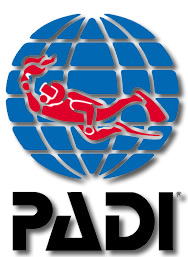 |
Тесты и Экзамены
|
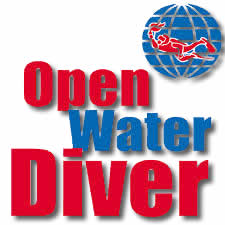 |
|---|---|---|
|
||
|
|
|
|
|
|
Список курсов PADI |
Макс Лукаш © 2013 / PRO Check —> PADI #320969. |
v.0.0.1
Preparing for the PADI Open Water Diver Course
The PADI Open Water Diver (OWD) final exam consists of 50 questions, so we have included these practice questions (and answers) to help you study for this test. Most of the PADI Open Water Diver final exam questions are multiple-choice questions, along with a couple of ‘ place the answers in the correct order’ questions. You don’t have a time limit to complete the exam. In fact, you most likely have seen the questions in the review sections of your book in one form or another. All of the review sections in the book are extremely helpful when preparing to take the test, and there is no downside to doing them, right? If you are looking for PADI final exam answers you are in the right place. Don’t stress out as this test is designed for a 10-year-old to pass!
You need to answer questions about the basic principles of scuba diving, which shows that you know how to plan dives, choose the right scuba gear and understand underwater signals and diving procedures. You can learn this information in the PADI Open Water Diver Manual or by completing the PADI Open Water Diver eLearning course. Your instructor will demonstrate each skill for you and will get a chance to show you have learned the skills during your confined water dives. At the end of the course, you will take the final exam.
Download a formatted copy of these questions and our exam preparation guide and print it out in preparation for your test for $8
55 Practise Open Water Diver Final Exam Questions
-
Download a formatted copy of 55 Open Water Diver Practise Questions & Answers as a PDF.
We also have a new Payhip store which makes it easier to preview the book before you buy it: Buy Now
Buy our new RDP handout here
Check our Open Water Diver Activity Sheets for Scuba Gear, Common Words & Diving Hand Symbols.
OWD Scuba Diving Activity Sheets
-
Open Water Diver Activity Sheets for Scuba Gear, Common Words & Diving Hand Symbols.
- 7 pages
Tips From An Experienced Instructor
Hi there! I’m Mary, and I have been a PADI Open Water Scuba Instructor and Master Scuba Diving Trainer for over 10 years. This means I have collected a fair amount of experience in teaching and examining Open Water Diver courses, and I want to share some tips with you. This way, you might find a few pointers to help you successfully completing your license and becoming a certified diver!
The Open Water Diver course consists of 3 major parts: theory, confined water, and open water dives. All parts must be successfully completed in order to obtain the most sought-after dive certification worldwide. Therefore, being great at theory and not so confident in water, or vice versa, is not a good start to your life as a diver.
Too many times I have seen students failing their theory exam, thinking the only one that matters is the practical part, intoxicated by the idea of swimming next to a shark or visiting a shipwreck. Remember, no good diver should ever ignore the basic rules of physics and physiology that your OWD course taught you!
Another important skill to master, definitely underrated, is the care of the equipment. In my experience as a dive guide, I have encountered certified divers that had no idea how to set up their own gear, because their instructor never taught them and they always did it for them. Wow! Learning how to set up and maintain your equipment, including after-dive care, is such an important skill that many diving agencies specify a minimum number of times you are required to perform this skill throughout your course. Would you buy a car, without knowing how to open the trunk or changing a light?
Moving on to the underwater skills, there is one particular exercise that often represents a huge obstacle for dive students: the dreaded mask removal skill! If there is one single skill that I have witnessed pushing students to quit, even those that brilliantly succeeded in all other parts of the course, this is the one. The fear and discomfort given by water in our eyes and nose becomes, for some, unbearable; however, my suggestion is to keep in mind one single concept: why do we learn this skill? Wouldn’t it be worse to find yourself completely unprepared, 18 meters or 60 feet underwater, with a broken, lost or misplaced mask, and not knowing how to react to it? Take it as a survival skill, because that’s what it truly is.
I’d like to conclude this little list of tips focusing on the importance of buoyancy underwater. This is in fact a skill that requires time, practice and focus, not one you’ll likely master in just four or five dives. A good instructor will be able to point out a few specific tips for every student, and the PADI Peak Performance Buoyancy Specialty is highly recommended at this level: it will give you extra knowledge and confidence under water, which eventually translates in a more enjoyable dive, better air consumption and even improved photographic skills!
Book a 30 minute Coaching Call on Zoom
If you would like help preparing for your Open Water Exam and need to ask a few questions from a PADI Divemaster then book a call with Schuan.
Schuan is a PADI Freediver, Divemaster and Scuba Instructor who would like to help you prepare for your exam.
He is a professional Commercial Diver with Australian Diver Accreditation Scheme (ADAS) Part 1-3 certified licenses, IMCA Dive Medic Technician (DMT) and Assistant Life Support Technician (ALST). He is currently working on material with us to help others in their professional careers.
Link to Book in: https://payhip.com/b/QqPXw
Online Open Water Diver Course on Teachable
55 Practise Q & A for the Final Exam
Here are some practice questions and answers to help you along:
Question 1
- An object which is naturally buoyant in fresh water would _____________ if the object is placed into saltwater.
(Naturally buoyant – does not sink or float).
Sink
b. Either sink or float
c. Do nothing
d. FloatAnswer: d – Float
Saltwater is more dense than fresh water because it contains more dissolved minerals in it. density causes more of an upward force (buoyancy) on an object the thus, causing the object which is naturally buoyant in fresh water to float in salt water.
Refer: Being a diver I – Buoyancy and controlling buoyancy - If you take a fully blown balloon to the bottom of the swimming pool. What will happen to the balloon and the air inside it?
The balloon will get bigger in size and the air inside will become less dense as gas molecules move further apart
b. The balloon will get smaller in size and the air inside will become less dense as gas molecules move further apart
c. The balloon will get bigger in size and the air inside will become denser as gas molecules move close together
d. The balloon will get smaller in size and the air inside will become denser as gas molecules move close togetherAnswer: d – the balloon will get smaller in size and the air inside will become more dense as gas molecules move close together
As water pressure increases the deeper you go, the volume of an air space will reduce causing the density of the gas molecules inside the balloon to move closer together. The balloon (volume of an air space) will get smaller and air density inside the balloon would increase.
Refer: Being a Diver I – Water pressure and air volume effects - If you turn a glass upside down trapping air within it by putting it in water and take the glass 10 meters underwater. The air space within the glass would:
Become half the size it was on the surface
b. Become two-thirds the size it was on the surface
c. become one-thirds the size it was on the surface
d. Not change in sizeAnswer: a – Become half the size it was on the surface
At 10 meters, the pressure is 2 bar. An air volume taken to this depth from the surface would decrease and become half the size.
Refer: Being a diver I – Water pressure and air volume effects - If you fail to equalise your body air space, it may be due to:
Sea sickness
b. Hypertension and heart diseases
c. Ear, nose or throat medical problem such as a cold or allergies
d. Anxiety and panic stateAnswer: c – ear, nose or throat medical problem such as a cold or allergies.
Congestion in ears, nose or throat which can block the air passages making equalisation difficult.
Refer: Being a Diver I – The Effects of Increasing Pressure on Body Air Spaces. - When descending and your ears or sinuses begin to hurt, it usually means that:
I have equalised my body air spaces
b. The mask strap is extremely tight
c. My mask is too small
d. I am experiencing a squeeze and need to equaliseAnswer: d – I am experiencing a squeeze and need to equalise
Pain in your ears or sinuses usually means that they have not been equalised. You are required to halt your descent, ascend slowly and relieve the pressure in your ears or sinuses. After relieving pressure, attempt to re-equalise. You are required to end the dive if you fail to equalise.
Refer: Being a Diver I – The Effects of Increasing Pressure on Body Air Spaces - What is the best position for you to alternate air source?
Loose by your side, so you can find it fast
b. The triangle area formed by your chin and lower corners of the rib cage
c. To the base of your cylinder
d. In the back of your BCD between the shoulder blades and waistAnswer: b – The triangle area formed by your chin and lower corners of the rib cage.
The alternate air source attaches with a quick release in the triangle area formed by your chin and lower corners of the rib cage. It is important to avoid letting the alternate air source dangle unsecured from your kit.
Refer: Equipment I – Regulators. - Common cause of lung overexpansion
Scuba diving without a partner
b. Continuing diving when not properly weighed
c. Being dehydrated before scuba diving
d. Holding your breath while scuba divingAnswer: d – Holding your breath while scuba diving
Holding your breath and blocking off your lungs could be fatal. When ascending it could cause the lungs to overexpand which may lead to rupture resulting into paralysis and death. Breathing ceaselessly and continuously while scuba diving keeps the body air passages open allowing the expanding air to escape.
Refer: Being a Diver I – The Effects of Decreasing Pressure on Body Air Spaces. - A cylinder of air which lasts 60 minutes for normal surface breathing; assuming same factors, how long would the same cylinder of air last at 20 meters underwater breathing normally?
12minutes
b. 15minutes
c. 20minutes
d. 60minutesAnswer: c – 20minutes
For every 10 meters underwater, there is an increase of 1 atmosphere of pressure (atm) to the standard 1atm at surface level. Thus, 20meters underwater is 2atm + 1atm of surface level = 3atm. - Recommended visual inspection of your scuba cylinder should be?
Every six months
b. Once a year
c. Once every two years
d. Every five yearsAnswer: b – once a year
Annual visual inspection is recommended to check for internal corrosion, contamination, or damage
Refer: Cylinders. - The DIN valves:
Are made of durable plastic
b. Contain a spring-operated shut-off valve which is held open by cylinder pressure
c. Has an o-ring within
d. Contain threaded openings to screw the regulators intoAnswer: d – contain threated opening to screw the regulators into.
The regulators with the DIN system screw into the valve, contrary to the yoke system which holds the regulator first stage to the cylinder with a clamp.
Refer: Equipment I – Cylinders. - __________________ is part of proper care for your scuba cylinders?
Sand it and repaint it every year
b. Dry it in the sun regularly
c. Keep some air within
d. Have pressure tests every monthAnswer: c – Keep some air within
To prevent moisture build up which causes corrosion, it is important to keep some air within the cylinder. It is important to have annual visual inspection and to have pressure tests at regular intervals of two-to-five years. Store the cylinder in an upright position in a safe place, away from intense heat.
Refer: Equipment I – Cylinder Care. - Referring to the picture below, each regulator part has been numbered. Please choose the correct choices for the numbered regulator part.
a. Regulator first stage
b. Regulator second stage
c. Alternate air source second stage
d. Low pressure inflator hose for the BCD. e. Instrument console/gauge/computerAnswer:
1 – a: regulator first stage
2 – b: regulator second stage
3 – c: alternate air source second stage
4 – e: instrument console/gauge/computer
5 – d: low pressure inflator hose for the BCD
Refer: Equipment I – Regulators. - Looking at objects underwater have an illusion of seeming ___________________ than looking on the surface.
Larger, nearer
b. Larger, farther away
c. Smaller, nearer
d. Smaller, farther awayAnswer: a – larger, nearer.
Light refracts when travelling through the water and into the mask making an illusion of objects appearing larger and nearer than actuality.
Refer: Being a Diver II – Seeing and Hearing as a Diver. - What travels faster in water than air?
Hint: it is why you cannot easily tell the source.
Sound
b. Aquatic life
c. Current
d. LightAnswer: a – sound.
Sound travels faster in water than in air making it difficult to determine the source of sound.
Refer: Being a Diver II – Hearing Underwater. - What is the recommended stay distance of your dive flag?
5meters
b. 15meters
c. 30meters
d. 60metersAnswer: b – 15 minutes.
There are no specific local laws regarding dive flags stay distance, however, stay within 15meters of the flag unless other laws that specify.
Refer: Equipment III – Dive Flags. - If it difficult and tough breathing underwater, you should:
Inflate the BCD
b. Stop all activity and rest, holding onto something for support if available and possible
c. Swim to your partner and signal for help
d. Execute a controlled swimming ascent [CESA: swimming to the surface saying the ah-h-h-h sound]Answer: b – stop all activity and rest, holding onto something for support if available and possible
When you are overexerted, you find it difficult and tough to breath underwater. It is important to immediately stop all activity and rest while holding onto something for support to restore normal breathing. Only continue after you have restored normal, slow paced breathing rate.
Refer: Being a Diver II – Overexertion. - When descending, the wet suit will:
Compress from water pressure and you will lose buoyancy and warmth
b. Expand from water pressure and you will lose buoyancy and warmth
c. Compress from water pressure and you will gain buoyancy and warmth
d. There will be no change in thickness, with no change in buoyancy and warmthAnswer: a – compress from water pressure and you will lose buoyancy and warmth.
Small air traps in your wet suit will compress the deeper you descend causing your buoyancy to decrease and affecting the warmth. To control your buoyancy, add small amounts of air to your BCD frequently during the descent.
Refer: Being a Diver II – Descents in Open Water. - You are properly weighted for diving if you:
Float at neck level with BCD approximately half full while holding a normal breath of air
b. Sink slowly with empty BCD while holding a normal breath of air
c. Float at eye level with empty BCD while holding a normal breath of air
d. Sink easily with BCD approximately half fullAnswer: Float at eye level with empty BCD while holding a normal breath of air.
Having a good buoyancy and trim is having the right amount of weight. Thus, when you exhale, you should be able to slowly sink.
Refer: Your Skills as a Diver II – Weight Check and Proper Weighting.
Choose the best answer for the signal shown below.
Stop, hold, stay there
b. Go back
c. Please be quiet
d. Ascend or go upAnswer: a – stop, hold, stay there
Refer: Your Skills as a Diver I – Hand Signals.- Choose the best answer for the signal shown below.
Which way is the right way
b. Something is wrong, not okay
c. Ascend
d. Everything is okayAnswer: b – something is wrong, not okay
Refer: Your Skills as a Diver I – Hand Signals. - If you get separated from your buddy, the general protocol is to:
Ascend immediately, wait a minute and then go back underwater
b. Search for your buddy for a minute, then go up to reunite with your buddy at the surface
c. Go to the surface immediately and get out of the water
d. Look for your buddy’s bubbles and follow to find your buddyAnswer: b – search for your buddy for a minute, then go up to reunite with your buddy at the surface
These general procedures should be adhered to when experiencing buddy separation.
Refer: Being a Diver II – The Buddy System. - You are most likely to become confused about the direction of up or down in ________________________.
Midwater
b. Surface
c. Bottom
d. Near surfaceAnswer: a – midwater
During descent and ascent in reduced visibility, the diver may feel disoriented particularly in midwaters.
Refer: Being a Diver III – Visibility. - When there is a mild current at the beginning of your dive. How should you begin the dive?
Dive with current
b. Diver across current
c. Dive against or into current
d. Dive at an angle to currentAnswer: c – dive against or into current
By swimming into current for the first part of your dive, the current will carry you back to where you started during the second part.
Refer: Being a Diver III – Water Movement. - Underwater contents of the bottom can cause changes in:
Visibility (see far underwater)
b. Temperature (warmth underwater)
c. Current (movement of water)
d. Buoyancy (sink or float underwater)Answer: a – visibility (see far underwater)
Visibility is affected by contents of water: nature and composition of particles present. Large, heavy particles (rocks or gravel) settle relatively quicker than small, light particles (clay or mud) which can remain suspended for long periods of time.
Refer: Being a Diver III – Visibility. - Aquatic life related injuries occur because the animals are ________________________.
Hungry
b. Curious
c. Injured
d. Defend modeAnswer: d – defend mode.
A large portion of aquatic life related injured are a result of defensive actions by the animals. Generally, such injuries are avoided by being mindful, aware, and respectful of the aquatic animals.
Refer: Being a Diver III – Aquatic Life. - Diver at the surface is moving quickly with jerk movements, has the mask off the face, regulator/snorkel out of the mouth and does not respond to directions. The diver is:
Diver practising okay signal
b. Performing predictive safety checks
c. Excited and overwhelmed with the dive
d. Showing signs of distress and troubledAnswer: d – showing signs of distress and troubled
Divers who are distressed and troubled often will have the mask of their foreheads and regulator/snorkel out of the mouth, not using breathing equipment. Divers often present with wide unseeing eyes, quick jerky movements, who don’t follow instructions. These divers require immediate help as they may continue to struggle in distress until exhaustion.
Refer: Being a Diver III – Surface Problem Management – Responsive Diver. - You are close to your diving buddy and midway realise that you are out of air. The most appropriate response is to:
Switch to your buddy’s alternate air source
b. Conduct a CESA [Controlled Emergency Swimming Ascent – swimming up to the surface making a continuous sound like ah-h-h]
c. Make a buoyancy emergency ascend by dropping all the weight system
d. Switch to your buddy’s alternate air source and continue with the diveAnswer: a – switch to your buddy’s alternate air source
When you are out of air, it is best to make an alternate air source ascent using your buddy’s alternate air source
Refer: Being a Diver III – Underwater Problem Management. - When your regulator begins to free flow whilst underwater, you should:
Conduct a CESA [Controlled Emergency Swimming Ascent – swimming up to the surface making a continuous sound like ah-h-h]
b. Do nothing
c. Hold the regulator without sealing mouth around mouthpiece and ‘sip’ air needed to ascend
d. Execute a buoyant emergency ascentAnswer: c – Hold the regulator without sealing mouth around mouthpiece and ‘sip’ air needed to ascend
You can breath from a free-flowing regulator by ‘sipping’ the air as you need it. Do not seal your moth around mouthpiece. Initiate ascent as the free-flow will exhaust the air supply quickly.
Refer: Being a Diver III – Underwater Problem Management. - In a hypothetical scenario, on a dive you fail to watch your SPG and run out of air. If your buddy if close by your best option is to ______________________________________. Alternatively, you can ________________________________________, if you are in shallow water and the surface is close than your buddy.
Ascend using your buddy’s alternate source of air/ make a CESA
b. Ascend using your buddy’s alternate source of air/ make a buoyant emergency ascend
c. Make a normal ascend/ ascend using your buddy’s alternate source of air
d. Make a CESA/ make a normal ascendAnswer: a – Ascend using your buddy’s alternate source of air/ make a CESA
When you are out of air, your best option is to make an ascend using your buddy’s alternate source of air. Conducting a CESA where it is fairly shallow with the surface is close than your buddy.
Refer: Being a Diver III – Underwater Problem Management. - When a diver is injured who is out of the water and is non-responsive to touch or sound. The first, most appropriate thing to do would be:
To check if diver is breathing
b. To keep diver warm
c. To decide the causative event
d. To provide oxygenAnswer: To check if diver is breathing
Your highest priority to the diver who is unresponsive to touch, or sound is to make sure the diver is breathing. Provide rescue breath when necessary and immediate contact emergency medical care.
Refer: Being a Diver III – First Responder Care for Diving-Related Emergencies. - Fill the cylinders at known and reliable dive centre and make sure not to use air that tastes or smells bad, nor use air from compressor designed to fill car tires. The main objective of this practice is to:
Decrease likelihood of gas narcosis
b. Decrease risk of lung overexpansion injuries
c. Decrease risk of breathing contaminated air
d. Increase the diving experienceAnswer: c – decrease risk of breathing contaminated air
Contaminated air is rare because it is an avoided circumstance by filling the cylinders at reliable and reputable scuba air sources. Professional dive operational resorts take care of their fill system and understand the value of regular air testing
Refer: Being a Diver IV – Contaminated Air. - Divers who tend to act foolishly at depth mainly due to gas narcosis begin to act normally again if they:
Ascend to a shallower depth
b. Regulate their breathing
c. Signal buddy for help
d. Dive within no stop limitsAnswer: a – ascend to a shallower depth
Divers who experience gas narcosis should immediately ascend to a shallower depth. Gas narcosis generally fades quickly when you ascend to a shallower depth
Refer: Being a Diver V – Gas Narcosis. - Increase probability for risk of decompression sickness (DCS) if:
Dive in poor visibility, strong current water, and rough seas
b. Dive while cold, sick, mentally exhausted, thirsty, or injured
c. Do not look after my equipment
d. Using a dive computerAnswer: b – dive while cold, sick, mentally exhausted, thirsty, or injured
Secondary factors which can contribute to developing decompression sickness include fatigue, dehydration, high body fat, injuries, mental exhaustion, age, poor fitness, alcohol consumption before or after dive, high intensity exercise before, during, after a dive.
Refer: Being a Diver IV – Decompression Sickness. - When experiencing decompression sickness (DCS) it is recommended to:
Stop diving until you recover and feel better
b. Go back in the water
c. Breath 100% oxygen and immediately contact emergency medical care
d. See a doctor when you are freeAnswer: c – breath 100% oxygen and immediately contact emergency medical care
For a suspected case of DSC illness, contact emergency medical care. You should lie down and breath emergency oxygen. It is estimated that almost all cases of decompression illness require recompression chamber treatment and management.
Refer: Using Dive Computers and Tables II – First Aid Treatment for Decompression Illness. - The first step in using the dive computer is to ___________________
Configure the time and date
b. Read manufacturer’s instruction manual
c. Calibrate for enriched air nitrox
d. Configure for fresh or salty water divesAnswer: b – read manufacturer’s instruction manual
It is the diver’s responsibility to read and understand the manufacturer’s instruction manual for the dive computer in order to use it effectively.
Refer: Using Dive Computers and Tables I – Planning Dives with Your Computer. - Planning a dive with a dive computer; use the ‘plan’ or ‘no stop scroll’ mode to determine which of the following:
Maximum depth of previous dive
b. Maximum allowed time limits for depth (approximately in 3meters)
c. Whether your dive computer is compatible with your buddy’s dive computer
d. To ensure perfect settings for backup computerAnswer: b – maximum allowed time limits for depth (approximately in 3meters)
With most dive computers, you scroll depths in 3meters increments, displaying maximum time allowed per depth. Thus, you plan dives with your dive computer by activating it and scrolling the no stop limits.
Refer: Using Dive Computers and Tables I – Planning Dives with Your Computer. - During a computer assisted dive:
Each diver requires a personal computer
b. Each buddy requires a personal computer
c. Up to four divers may share a computer
d. All divers may follow the dive guide’s computerAnswer: a – each diver requires a personal computer
Each diver requires a computer in a computer assisted dive and the buddy team should follow the most conservative computer to turn or end a dive.
Refer: Using Dive Computers and Tables I – Diving with Your Computer. - You should not turn off a dive computer between dives because:
The dive master may refuse or object because you cannot recall the dive information for logging
b. The dive computer would lose memory of previous dive and not calculate repetitive dives accurately
c. It may not switch on or may take a long to switch on
d. Doing so is strenuous for the batteries and may cause the dive computer to malfunctionAnswer: b – the dive computer would lose memory of previous dive and not calculate repetitive dives accurately
The dive computer tracks personal theoretical nitrogen levels continuously during all the dives and surface intervals. For the diver’s safety, to track and record an accurate account, the diver must not turn off their computer and need to use the same computer for the entire diving day on all dives.
Refer: Using Dive Computers and Tables I – Repetitive Diving. - If the diver accidentally exceeds the computer’s ‘no stop limits’, the diver should:
Make a safety stop for 3minutes at 5meters
b. Follow the computer’s instructions for decompression
c. Surface immediately, breath oxygen and report the incident to the dive master
d. Make a controlled ascend and refer to manufacturer’s instruction for decompression proceduresAnswer: b – follow the computer’s instructions for decompression
If and when the diver exceeds the ‘no stop limit’, they shall have to make an emergency decompression stop. The dive computer will go into the decompression mode and guide the diver by providing the depth of emergency decompression stop and how long you have to stay before you can ascend to surface. Emergency decompression stops are required so that the diver does not exceed the theoretical nitrogen levels.
Refer: Using Dive Computers and Tables II – Emergency Decompression Stops. - If the diver is diving in cold water or under strenuous situational conditions, the diver should:
Add extra safety margin and stay well within the computer’s limits
b. Stay longer because nitrogen absorption will be slower
c. Continue as the dive computer will probably not work at all
d. Not do anything specialAnswer: a – add extra safety margin and stay well within the computer’s limits
If the diver gets cold or exercises a lot during a dive, they may have more dissolved nitrogen than calculated by the dive computer. High levels of dissolved nitrogen increase risk of decompression sickness (DCS) risk.
Refer: Using Dive Computers and Tables II – Cold and Strenuous Dives. - If a diver’s computer fails during a dive, they can use the backup computer to continue with the dive. If the diver is not wearing a backup dive computer, the diver should:
Ascend, make a safety stop and end the dive
b. Borrow the buddy’s backup dive computer
c. Continue with the dive until low on air but do not make any repetitive dives
d. End the dive and surface immediatelyAnswer: a – ascend, make a safety stop and end the dive
The procedure for a failed dive computer is to signal your buddy, ascend, make a safety stop and end your dive. You cannot continue the dive without being able to track your dive profile.
Refer: Using Dive Computers and Tables I – Diving with Your Computer. - If a diver makes two dives in one day and is flying home on a commercial plane. How long should I wait until I can fly:
0hours
b. 18hours
c. 24hours
d. 48hoursAnswer: b – 18hours
It is recommended to have a minimum pre-flight surface interval of 18hours for repetitive dives or multiday dives.
Refer: Using Dive Computers and Tables II – Flying After Diving and Altitude Diving. - As a new PADI Open Water Diver, the recommended maximum depth is ________________, compared to the maximum depth of all recreational scuba divers or experienced diver is _______________.
10meters/ 18meters
b. 12meters/ 30meters
c. 18meters/ 40meters
d/ 24meters/ 58metersAnswer: a – 10meters/ 18meters
Refer: Being a Diver V – Continuing Your Adventure. - When diving at an altitude of above 300meters, the diver:
Does not need to follow special procedures or protocols
b. Cannot use their dive computer
c. Does not need to follow special procedures instead need to set the computer for the altitude
d. Needs to follow special procedures and may need to set the computer for the altitudeAnswer: d – needs to follow special procedures and may need to set the computer for the altitude
Normally you surface to lower atmospheric pressure, if diving at an altitude of 300meters of higher you need to use altitude diving procedures. Most of the dive computers automatically adjust to the altitude and have optional settings you can adjust for altitude diving.
Refer: Using Dive Computers and Tables II – Flying After Diving and Altitude Diving. - Case scenario: if you dive to 18meters for 33minutes, have a 30minutes surface interval and plan to dive to 17meters. What is the maximum allowed time for the second dive?
19minutes
b. 21minutes
c. 23minutes
d. 32minutesAnswer: d – 32minutes
RDP Table 1: find depth on the top most row, following the column down to the time or next great time, going across to find the pressure group: 18meters to 34/33minutes àpressure group M
RDP Table 2: Follow the pressure group M to find 30minutes (between 26-32minutes) and follow the column down to pressure group H
RDP Table 3: Follow the next deepest depth of 18meters, going across to meet group H. The number in the blue box is 32minutes which is the allowed bottom time.
Refer: RDP/eRDPML Instructions for Use booklet. - Case scenario: if you plan to make two dives: 1st dive to 18meters for 49minutes and 2nd dive to 18meters of 24minutes. What is the minimum surface intervals between these two dives safely?
26minutes
b. 32minutes
c. 54minutes
d. 59minutesAnswer: b – 32minutes
RDP Table 1: find depth on the top most row, following the column down to the time or next great time, going across to find the pressure group: 18meters to 51/49minutes àpressure group T
RDP Table 3: Follow the next deepest depth of 18meters, going across until you find a time in the blue box. The number in the blue box is 24minutes, following this to pressure group L.
RDP Table 2: Follow the L column from the bottom until it meets the T row, showing the minimum surface interval is 32minutes. Refer: RDP/eRDPML Instructions for Use booklet. - Case scenario: if you dive to 17meters for 47minutes, have a 30minutes surface interval and do a second dive to 17meters. Losing track of time, you notice my bottom time is now 25minutes. According to the general rules what should you do?
Ascend immediately to 5meters and stay there for at least 8minutes before going to surface. You should not dive for 6hours
b. Go to the surface immediately and contact the nearest recompression chamber
c. Ascend immediately to 5meters and stay there for at least 3minutes before going to surface. You should not dive for 2hours
d. Ascend immediately to 3meters and stay there until you use up your air. You should not dive for 24hoursAnswer: a – ascend immediately to 5meters and stay there for at least 8minutes before going to surface. You should not dive for 6hours
RDP Table 1: find the next greatest depth on top row, follow the column down to next greatest time and across to find pressure group. 18meters to 48/47minutes à pressure group S.
RDP Table 2: Follow pressure group S to find 30minutes (between 28-32minutes) and follow column down to pressure group L.
RDP Table 3: follow the next greatest depth of 18meters going across to meet L. The number in the blue box is 24 – is allowed bottom time.
Refer: RDP/eRDPML Instructions for Use booklet. - Case scenario: a group of advanced Open Water Divers plans to make two dives. The 1st dive is on a reef in 22meters of water for 20minutes. The group has an surface interval of 1hour then have a 2nd dive is on s wreck in 18meters of water with a planned bottom time for 30minutes.
L
b. K
c. S
d. RAnswer: d – R
RDP Table 1: find depth on the top most row, following the column down to the time or next great time, going across to find the pressure group: 22meters to 21minutes àpressure group I/K
RDP Table 2: Follow the pressure group to find 1hour and follow the column down to pressure group C
RDP Table 3: Follow the group C to next deepest depth of 18meters. The number in the white box is 15/14 – is the residual nitrogen time. Add this time to the bottom time: 15/14 + 30minutes = 45/44minutes
RDP Table 1: follow the 18meters coloumn down to the time or next greatest time: pressure group R.
Refer: RDP/eRDPML Instructions for Use booklet. - Case scenario: you and your buddy are planning to dive at a site where the water and air temperatures are near to freezing. We plan to dive to 18meters for 30minutes. What dive profile would you use when planning our dive?
24meters for 40minutes
b. 22meters for 30minutes
c. 20 meters for 40minutes
d. 18meters for 30minutesAnswer: b – 22meters for 30minutes
Available on the RDP Table: if you are planning a dive in cold water or under conditions that might be strenuous, plan the dive assuming the depth is 4 meters deeper than actual.
Refer: RDP/eRDPML Instructions for Use booklet. You can buy our RDP handout here. - Case scenario: You are an Advanced Open Water Diver and plan to do 3dives. The 1st dive is 25meters for 22minutes followed by a 52minutes surface interval. The 2nd dive is 20meters for 27minutes followed by a 62minutes surface interval. The 3rd dive is to 18meters – what would be the maximum allowable bottom time for the 3rd dive?
21minutes
b. 25minutes
c. 34minutes
d. 54minutesAnswer: c – 34minutes
RDP Table 1: find the next greatest depth on top row, follow the column down to next greatest time and across to find pressure group. 25meters to 22minutes à pressure group L.
RDP Table 2: Follow pressure group to find and follow column down to pressure group D.
RDP Table 3: follow D down to meet 20meters. The number in the white box is 15/13 – is the residual nitrogen time.
Add this time to the bottom time: 15/13 + 27minutes = 42/40minutes
Refer: RDP/eRDPML Instructions for Use booklet.
See the RDP/eRDPML Instructions for Use booklet. You can buy our RDP handout here
We have recently produced an online exam prep course on the Teachable platform: https://openwatercourses.teachable.com/ which includes our downloadable guide with practise test questions, diving hand signals handout and an online quiz for $35.
Download a formatted copy of these questions and our exam preparation guide and print it out in preparation for your test. $8
55 Practise Open Water Diver Final Exam Questions
-
Download a formatted copy of 55 Open Water Diver Practise Questions & Answers as a PDF.
Open Water Diver Guide with Practise Questions
-
The PADI Open Water Diver (OWD) final exam consists of 50 questions, so we have included these practice questions (and answers) to help you study for this test.
We include things to know before you take the test, tips from an experienced instructor, trick for taking the exam, what is a RDP and 57 practise questions.
OWD Scuba Diving Activity Sheets
-
Open Water Diver Activity Sheets for Scuba Gear, Common Words & Diving Hand Symbols.
- 7 pages
For more articles on the PADI Open Water Exam read 12 Ways to Fail Your PADI Open Water Exam
D float.
Salt water is heavier than fresh water because it has dissolved minerals in it. This means it causes more upward force (buoyancy) on an object. An object that is neutrally buoyant in fresh water would float in salt water because there is greater upward force.
See Being a Diver I — Buoyancy and Controlling Buoyancy.
B The balloon will get smaller and the air inside the balloon will be more dense (molecules move closer together).
As water pressure increases, the volume of an air space will decrease. This causes the density of the air inside to increase and air molecules are pushed closer together. The balloon would get smaller and the air density inside would be greater.
See Being a Diver I — Water Pressure and Air Volume Effects.
2) I blow up a balloon, tie it off, and take it to the bottom of the swimming pool. What will happen to the balloon and the air inside it?
A The balloon will get bigger and the air inside the balloon will be less dense (molecules move further apart).
B The balloon will get smaller and the air inside the balloon will be more dense (molecules move closer together).
C The balloon will get bigger and the air inside the balloon will be more dense.
D The balloon will get smaller and the air inside the balloon will be less dense.
C I am feeling a squeeze and need to equalize.
Pain in your ears or sinuses means that they aren’t equalized. Stop your descent and ascend slightly to relieve pressure on your ears. Then attempt to equalize again. If you can’t equalize, end the dive.
See Being a Diver I — The Effects of Increasing Pressure on Body Air Spaces.
B In the triangle area formed by my chin and the lower corners of my rib cage.
Your alternate air source attaches with a quick release in the triangle area formed by your chin and the lower corners of your rib cage. Avoid letting your alternate air source dangle unsecured from your kit.
See Equipment I — Regulators.
D Holding my breath while scuba diving.
Blocking off your lungs by holding your breath and ascending could cause them to overexpand and rupture, which is a serious injury that could result in paralysis and death. Breathing continuously while scuba diving keeps air passages open allowing expanding air to escape.
See Being a Diver I — The Effects of Decreasing Pressure on Body Air Spaces.
Модераторы: трофи, KWAK, DukeSS
-
rOgaLik
- Участник
- Сообщения: 269
- Зарегистрирован: 27-10-2009 12:31
- Откуда: Moscow
- Контактная информация:
#1
Сообщение
Добавлено: 08-12-2009 20:04 Заголовок сообщения: Экзаменационные карточки PADI OWD
Приветствую…скоро сдача теории по ОВД, хотелось бы пробежаться по вопросам =)
У кого есть поделитесь плз желательно с правельными ответами дабы быстренько провериться
-
Ras
- Активный участник
- Сообщения: 3968
- Зарегистрирован: 07-12-2009 23:14
- Откуда: Москва
#2
Сообщение
Добавлено: 08-12-2009 20:14 Заголовок сообщения:
А под водой кто Вам будет подсказывать?
Это мое оценочное суждение
-
alemola
- Участник
- Сообщения: 124
- Зарегистрирован: 03-04-2009 11:31
#3
Сообщение
Добавлено: 08-12-2009 20:16 Заголовок сообщения:
Шпоргалки напиши
-
rOgaLik
- Участник
- Сообщения: 269
- Зарегистрирован: 27-10-2009 12:31
- Откуда: Moscow
- Контактная информация:
#4
Сообщение
Добавлено: 08-12-2009 20:25 Заголовок сообщения:
Ras писал(а):А под водой кто Вам будет подсказывать?
под водой у меня все на 5+ можите прийти и лично проверить =)
это не для написания шпаргалок а чисто для себя…все ли я прально понял и усвоил…учебник я читал =)
-
ico
- Активный участник
- Сообщения: 4628
- Зарегистрирован: 12-09-2007 11:46
- Откуда: оттуда
- Контактная информация:
#5
Сообщение
Добавлено: 08-12-2009 20:29 Заголовок сообщения:
rOgaLik писал(а):под водой у меня все на 5+ можите прийти и лично проверить =)
это не для написания шпаргалок а чисто для себя…все ли я прально понял и усвоил…учебник я читал =)
ЧистА для сИбя — в учебнике есть контрольные вопросы с Атветами.
-
rOgaLik
- Участник
- Сообщения: 269
- Зарегистрирован: 27-10-2009 12:31
- Откуда: Moscow
- Контактная информация:
#6
Сообщение
Добавлено: 08-12-2009 20:31 Заголовок сообщения:
ico писал(а):
rOgaLik писал(а):под водой у меня все на 5+ можите прийти и лично проверить =)
это не для написания шпаргалок а чисто для себя…все ли я прально понял и усвоил…учебник я читал =)ЧистА для сИбя — в учебнике есть контрольные вопросы с Атветами.
мне это и без вас известно, на них я отвечаю
я вроде бы русским языком спросил что мне требуется
-
alemola
- Участник
- Сообщения: 124
- Зарегистрирован: 03-04-2009 11:31
#7
Сообщение
Добавлено: 08-12-2009 20:47 Заголовок сообщения: Re: Экзаменационные карточки PADI OWD
Читаю по русски…
rOgaLik писал(а):Приветствую…скоро сдача теории по ОВД, хотелось бы пробежаться по вопросам =)
У кого есть поделитесь плзжелательно с правельными ответами дабы быстренько провериться
…так что вам требуется? вопросы — ответы …та есть-же в учебнике…боитесь инструктор PADI задаст вопрос не из учебника….
-
rOgaLik
- Участник
- Сообщения: 269
- Зарегистрирован: 27-10-2009 12:31
- Откуда: Moscow
- Контактная информация:
#8
Сообщение
Добавлено: 08-12-2009 21:00 Заголовок сообщения: Re: Экзаменационные карточки PADI OWD
alemola писал(а):Читаю по русски…
rOgaLik писал(а):Приветствую…скоро сдача теории по ОВД, хотелось бы пробежаться по вопросам =)
У кого есть поделитесь плзжелательно с правельными ответами дабы быстренько провериться
…так что вам требуется? вопросы — ответы …та есть-же в учебнике…боитесь инструктор PADI задаст вопрос не из учебника….
вот странные люди…сказал же официальные экзаменационные вопросы!
если у вас нету таковых или не готовы поделиться то проходите мимо и не флудите
-
alemola
- Участник
- Сообщения: 124
- Зарегистрирован: 03-04-2009 11:31
#9
Сообщение
Добавлено: 08-12-2009 21:15 Заголовок сообщения:
rOgaLik писал(а):
под водой у меня все на 5+
Завидую…
Не парьтесь, 100% будете счастливым обладателем плассстикаOWD …уплочено…
Напишите потом как сдавали экзамен!
-
rOgaLik
- Участник
- Сообщения: 269
- Зарегистрирован: 27-10-2009 12:31
- Откуда: Moscow
- Контактная информация:
#10
Сообщение
Добавлено: 08-12-2009 21:30 Заголовок сообщения:
alemola писал(а):
rOgaLik писал(а):
под водой у меня все на 5+Завидую…
Не парьтесь, 100% будете счастливым обладателем плассстикаOWD…уплочено…
Напишите потом как сдавали экзамен!
конечно напишу =) уже фрог освоил
-
Фишкин
- Активный участник
- Сообщения: 2214
- Зарегистрирован: 04-02-2007 11:33
- Откуда: C-Пб
#11
Сообщение
Добавлено: 08-12-2009 21:39 Заголовок сообщения:
Теперь надо научиться плавать без ласт задом наперед и дышать из баллона.
-
rOgaLik
- Участник
- Сообщения: 269
- Зарегистрирован: 27-10-2009 12:31
- Откуда: Moscow
- Контактная информация:
#13
Сообщение
Добавлено: 08-12-2009 21:52 Заголовок сообщения:
Фишкин писал(а):Теперь надо научиться плавать без ласт задом наперед и дышать из баллона.
неее я как нить абайдусь =)
мне повезло…данного мастера видел лично в воде…хорошо что я уже был на бортике..а то вдруг это заразно и передается через воду
-
rOgaLik
- Участник
- Сообщения: 269
- Зарегистрирован: 27-10-2009 12:31
- Откуда: Moscow
- Контактная информация:
#14
Сообщение
Добавлено: 08-12-2009 21:53 Заголовок сообщения:
я думаю не уместный совет =) пади и гуе…разные системы обучений =)
-
Сергей Дровников
- Активный участник
- Сообщения: 1456
- Зарегистрирован: 30-10-2009 10:57
- Откуда: Луганск
#15
Сообщение
Добавлено: 08-12-2009 22:01 Заголовок сообщения:
Если сдавать экзамен ПАДИ по ГУЕ, успех обеспечен
-
Дана
- Активный участник
- Сообщения: 6809
- Зарегистрирован: 16-01-2007 10:06
- Откуда: Moscow
#16
Сообщение
Добавлено: 08-12-2009 22:01 Заголовок сообщения:
rOgaLik писал(а):
Фишкин писал(а):Теперь надо научиться плавать без ласт задом наперед и дышать из баллона.
неее я как нить абайдусь =)
мне повезло…данного мастера видел лично в воде…хорошо что я уже был на бортике..а то вдруг это заразно и передается через воду
Новичок пошел тертый, голыми руками не возьмешь. Думаю, Вы приживетесь на этом форуме
Успешного экзамена и хороших заныров!
Последний раз редактировалось Дана 08-12-2009 22:21, всего редактировалось 1 раз.
Я видел секретные карты, я знаю, куда мы плывем,
Капитан, я пришел попрощаться с тобой и твоим кораблем (с) Наутилус Помпилиус
-
dydy
- Участник
- Сообщения: 135
- Зарегистрирован: 29-06-2003 00:01
- Откуда: Орёл
#17
Сообщение
Добавлено: 08-12-2009 22:20 Заголовок сообщения: Re: Экзаменационные карточки PADI OWD
rOgaLik писал(а):Приветствую…скоро сдача теории по ОВД, хотелось бы пробежаться по вопросам =)
У кого есть поделитесь плзжелательно с правельными ответами дабы быстренько провериться
Посмотрите личку.
С уважением Эдуард.
AOWD 0308U05653
-
rOgaLik
- Участник
- Сообщения: 269
- Зарегистрирован: 27-10-2009 12:31
- Откуда: Moscow
- Контактная информация:
#18
Сообщение
Добавлено: 08-12-2009 22:35 Заголовок сообщения:
Сергей Дровников писал(а):Если сдавать экзамен ПАДИ по ГУЕ, успех обеспечен
несомненно =) PADI начало, а дальше меня ждет GUE
-
Сергей Дровников
- Активный участник
- Сообщения: 1456
- Зарегистрирован: 30-10-2009 10:57
- Откуда: Луганск
#19
Сообщение
Добавлено: 08-12-2009 22:46 Заголовок сообщения:
Если изложить инструктору ПАДИ концепцию ДИР, то он может совсем сойти с ума. Длинный шланг и отсутствие трубки вызывает когнетивный диссонанс. Теория сбалансированного снаряжения и несбрасываемых грузов может привести к параличу.
-
Helga
- Афина Мальтийская
- Сообщения: 10848
- Зарегистрирован: 09-06-2006 23:02
- Откуда: Москва-Мальта
- Контактная информация:
#20
Сообщение
Добавлено: 08-12-2009 22:53 Заголовок сообщения:
Сергей Дровников писал(а):Если изложить инструктору ПАДИ концепцию ДИР, то он может совсем сойти с ума. Длинный шланг и отсутствие трубки вызывает когнетивный диссонанс. Теория сбалансированного снаряжения и несбрасываемых грузов может привести к параличу.
Стресс от отсутствия трубки ничто по сравнению с паникой от необходимости ее наличия на маске.
A step-by-step guide for fellow divers who are somewhat nervous ahead of the PADI Open Water Diver course.
In theory, an expert diver should be writing this post. Logically, he or she could tell you what to expect, give you insider tips and prepare you for the challenge ahead. Of course, as a newly qualified diver, I have one advantage over the experts: I know first-hand just how hard it is for the nervous first-timer.
I know what it’s like to almost back out of your first dive and to quit the course altogether. I also know how to get back on it.
Five months after my first attempt, I passed the PADI Open Water Diver course.
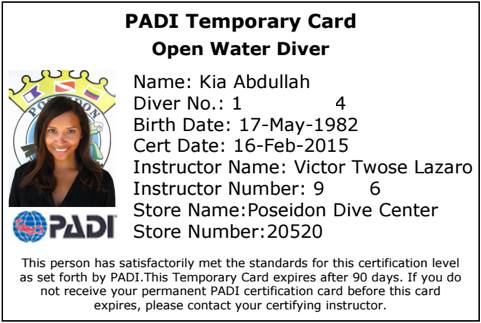
Since then, I’ve completed over 40 dives all around the world, taking on shipwrecks, plane wrecks, walls and bommies.
Here’s a step-by-step guide for fellow divers who are somewhat nervous ahead of the course. I cover the theory first and then the hard stuff: the confined water tests and the open water tests, touching on a few difficult points along the way.
Choosing a course
All PADI courses comprise the following:
- Knowledge development: theory work to help you understand the basic principles of scuba diving. This is reviewed in a final test in which you must score 75% or higher. If you fail, you can retake the test. See ‘PADI test questions’ below for more.
- Confined water dives: this is usually done in a pool or shallow water in the sea with the aim of teaching you basic scuba skills. See ‘PADI confined water tests’ below for more.
- Open water dives: you must complete four open water dives in which you demonstrate your skills. See ‘PADI open water tests’ below for more.
In choosing a course, firstly, make sure your dive centre is certified by PADI. There are centres all over the world that advertise the PADI Open Water Diver course but which aren’t actually certified. They will happily take your money and while you probably will learn to dive, you won’t be certified.
Secondly, if you’re a nervous diver, try to book a 4-day or even 5-day course. The intensive 3-day courses run through the practical tests very quickly with little time to coach weak swimmers. A longer course means more time for hand-holding (which I needed – literally).
PADI test questions
You will find the practical side of diving much easier if you read through the theory first. Your dive centre will supply you with a book and a DVD comprising five different chapters. If you can confidently answer the tests within the chapters and the knowledge reviews at the end of each, you will likely pass the exam without difficulty.
Depending on your learning style, it is possible to blitz through chapters 1-3 on one night and 4-5 on the second. Naturally, if you have more time to play with, then feel free to split up the studying even further.
To prepare for the PADI test questions:
- Go over the knowledge reviews
- Practise with flashcards
- Revise the dive signals
- Practise all the above with the Open Water Diver Course Ebook (PDF, $2.99)
Tips:
- For the ‘BWRAF’ check, substitute the clunky PADI acronym (‘Begin With Review And Friend’) for ‘Bruce Willis Ruins All Films’. It’s not true of course but it’s far easier to remember.
- For the five-point descent, use the SORTED acronym: Signal, Orientate, Regulator, Time, Equalise and Descend.
- There is no standard acronym for the different types of ascents (Normal ascent, Alternative air source ascent, Controlled emergency swimming ascent, Buddy breathing ascent, Buoyant emergency ascent), but they will come up so use mine: NACBB for ‘Not All Children Break Bad’ – it’s far from perfect but it works for me!
- Don’t be daunted by the dive tables. They seem complicated at first but are straightforward once you have been through the booklet. Check with your instructor if you will be using the manual tables or an electronic one. If the latter, you will only need a loose understanding of the former.
PADI confined water tests
The following is a list of the confined water tests (or ‘pool tests’) you will be expected to complete. According to my instructor, most nervous divers have difficulty clearing the mask (I certainly did!). If you have a snorkel and mask, practise this skill yourself before the course.
- 200m swim
- Tread water for 10 minutes
- Assemble, put on and adjust scuba gear
- Pre-dive safety check (BWRAF)
- Inflate and deflate BCD
- Clear snorkel on ascent by exhaling sharply and continue breathing without lifting face from water
- Swap from regulator to snorkel, snorkel to regulator several times without lifting face from water
- Descend underwater (SORTED)
- Clear water from your regulator (exhaling sharply and using purge button)
- Use your SPG and signal your remaining air
- Recover your regulator from behind your shoulder
- Recognise and respond to hand signals underwater
- Clear a partially flooded mask
- Clear a fully flooded mask
- Remove mask and breathe for one minute while stationary, replace and clear mask
- Remove mask and swim for at least 15 metres, replace and clear mask
- Breathe from a free-flowing regulator for 30 seconds (air blasts out of the regulator forcing you to ‘sip’ air from it)
- Demonstrate neutral buoyancy: float at eye level at the surface with no or minimal air in the BCD and while holding a normal breath; pivot from horizontal to vertical underwater several times; float in the ‘Buddha’ stance for 30 seconds
- Take off your scuba gear and put it back on at surface and at depth
- Tighten a loose cylinder band
- Disconnect and reconnect the low-pressure inflator at surface and at depth
- Swim and navigate with a compass at surface and at depth
- Remove and replace weights at surface and at depth
- Emergency weight drop at surface and at depth
- Cramp release on buddy and on yourself at surface and at depth
- BCD oral inflation at surface and at depth
- Out of air exercises: use alternate air source, provide alternate air source, practise buddy breathing for one minute while swimming
- Practise a controlled emergency swimming ascent (CESA)
- Ascend while equalising
- Tired diver tow for 25 metres
- Use inflatable signalling device
- Remove weights, scuba unit and fins in water too deep in which to stand and exit
- Post-dive care of scuba gear
Phew.
PADI open water tests
You must complete four open water dives in order to pass the course. Dive 1 will orientate you, get you comfortable with the scuba gear and test a few of the above skills. Dives 2 and 3 will rigorously test the above skills while Dive 4 is usually a more relaxed affair allowing you to use and enjoy your newly developed skills.
Final word
The most important thing to remember is to keep breathing and never hold your breath. If you feel panic rising, just continue breathing. If you can’t think through your flooded mask, just keep breathing. If you want to shoot up to the top, just keep breathing.
The second most important thing is to practise, practise, practise beforehand. The more time you spend in the water, the more confident you will become.
If I can do it after vomiting into the regulator five metres down and then again on the boat for good measure with a whopping 8kg around my waist, then so can you.
Good luck!
Enjoyed this post? pin it for later…
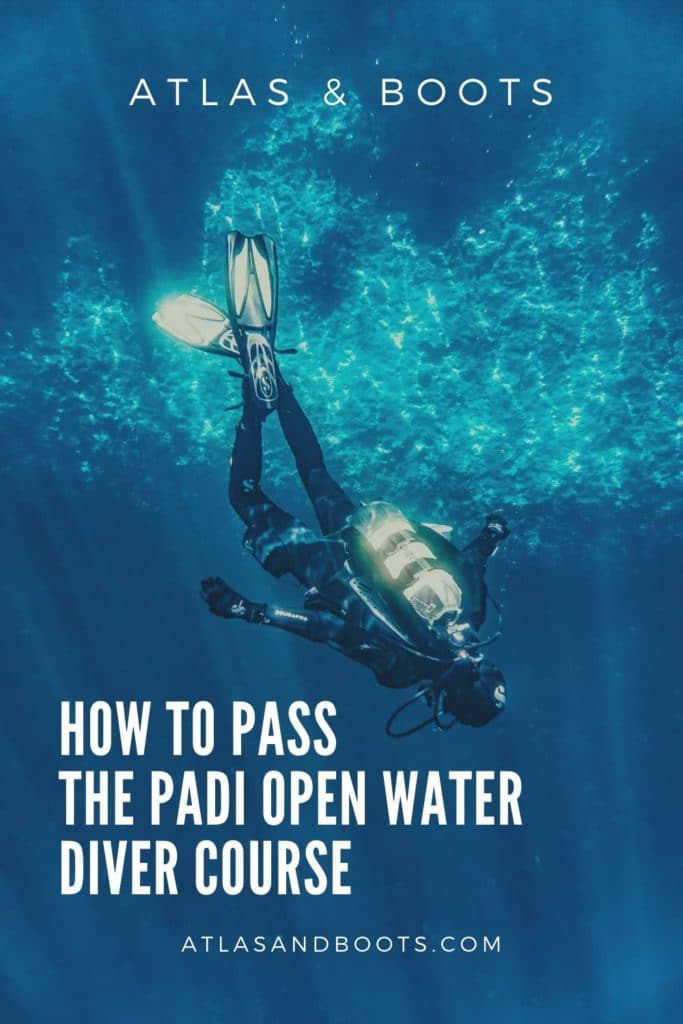
Lead image: Atlas & Boots
Предложите, как улучшить StudyLib
(Для жалоб на нарушения авторских прав, используйте
другую форму
)
Ваш е-мэйл
Заполните, если хотите получить ответ
Оцените наш проект
1
2
3
4
5

















